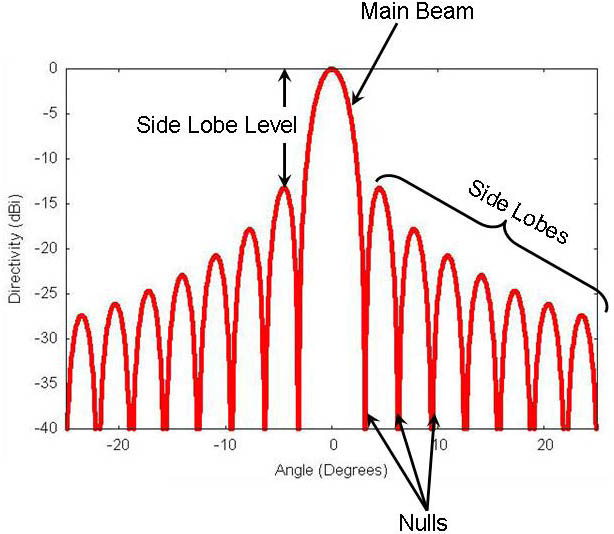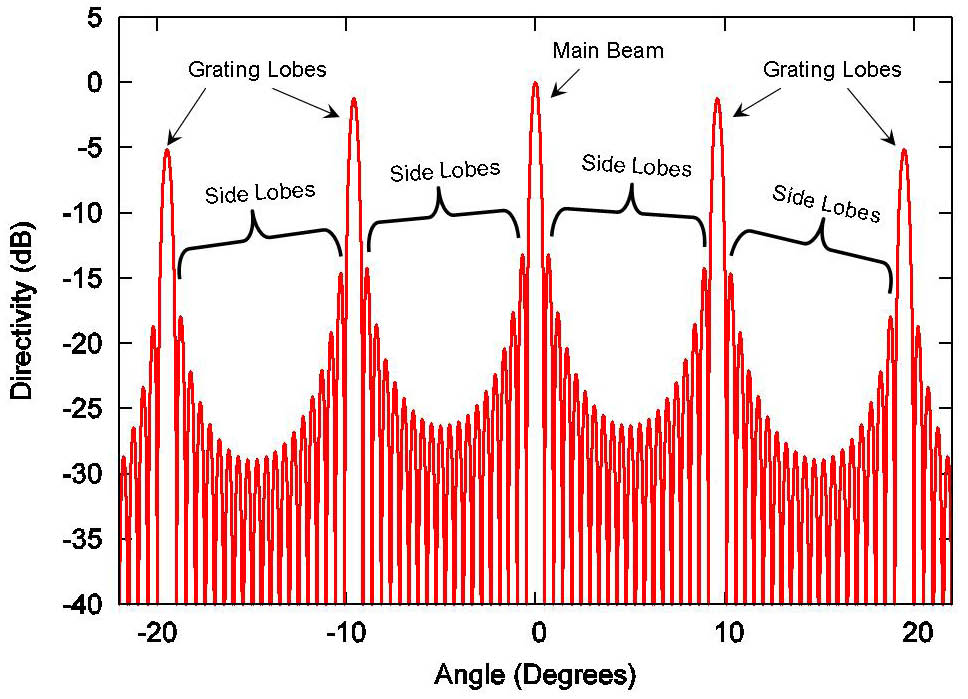Antenna radiation patterns are graphical representations of elements of the radiation characteristics of an antenna. The antenna pattern is usually a graphical representation of the antenna’s directional characteristic. It represents the relative intensity of the energy radiation or the amount of the electric or magnetic field strength as a function of the direction to the antenna. Antenna diagrams are measured or generated by simulation programs on the computer, for example, to graphically display the directivity of a radar antenna and thus estimate its performance.
|
|
 Antenna radiation pattern in cartesian coordinate system Antenna radiation pattern in cartesian coordinate system
|
Main lobe, side lobes and grating lobes
A lobe refers to a distinct peak or region in the radiation pattern of an antenna. The primary lobe is known as the main lobe, and other peaks are referred to as side lobes or back lobes.
Main lobe (also main beam)
The main lobe (also known as main beam) is the primary and most intense part of an antenna’s radiation pattern. It is the region where the antenna directs most of its energy, and it represents the direction in which the antenna is most effective at transmitting or receiving signals. The width of the beam can be characterized by the beamwidth, which is the angular width of the main lobe, typically defined between the half-power points (also known as the -3 dB points) of the main lobe.
Side lobes
Side lobes are the secondary, less intense peaks in the radiation pattern of an antenna, aside from the main lobe. They occur at various angles relative to the main lobe and can be significant in terms of their intensity. Side lobes can potentially interfere with or pick up unwanted signals, which can affect the overall performance of the antenna system. Minimizing the side lobes is important to ensure that the antenna’s energy is focused primarily in the desired direction and to reduce unwanted interference.
Grating lobes
For discrete aperture antennas (such as phased arrays) in which the element spacing is greater than a half wavelength, the spatial aliasing effect causes some sidelobes to become substantially larger in amplitude, and approaching the level of the main lobe; these are called grating lobes, and they are either identical, or nearly identical as shown in the figure, copies of the main beams.
Grating lobes are a special case of a sidelobe. In such a case, the sidelobes should be considered all the lobes lying between the main lobe and the first grating lobe, or between grating lobes. It is conceptually useful to distinguish between sidelobes and grating lobes because grating lobes have larger amplitudes than most, if not all, of the other sidelobes.

Artifacts and Grating lobes in LOFAR HBA sky image.
Artifacts in the context of LOFAR HBA refer to unintended distortions or errors in the data caused by various factors, including grating lobes. Artifacts can manifest as false signals, interference patterns, or distortions in the observed astronomical data.
Grating lobes can be a significant source of artifacts in LOFAR HBA observations. The additional lobes can cause interference by receiving or radiating signals in unintended directions, which can appear as false signals or distortions in the observed data.
In the HBA band, LOFAR is observed at 100-240 MHz, corresponding to a half-wavelength of around 0.65m-1.5m. The LOFAR HBA tiles are arranged in a regular, periodic pattern. When the spacing between elements or tiles is comparable to or greater than the wavelength of the signal, it leads to the formation of grating lobes. These lobes appear at angles where the array’s periodic structure causes constructive interference of the signal. This can result in additional, unwanted peaks in the radiation pattern, contributing to artifacts in the data.




